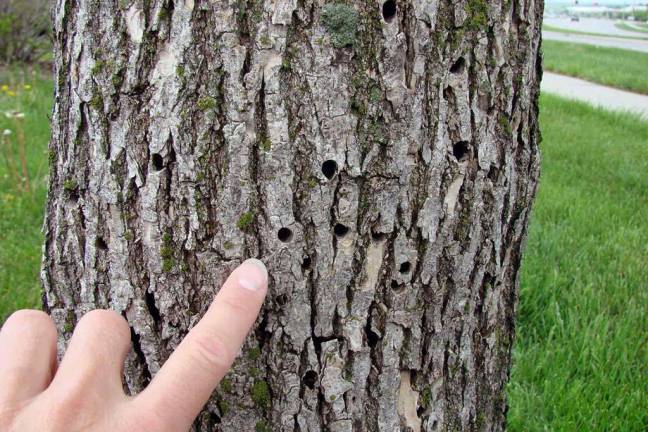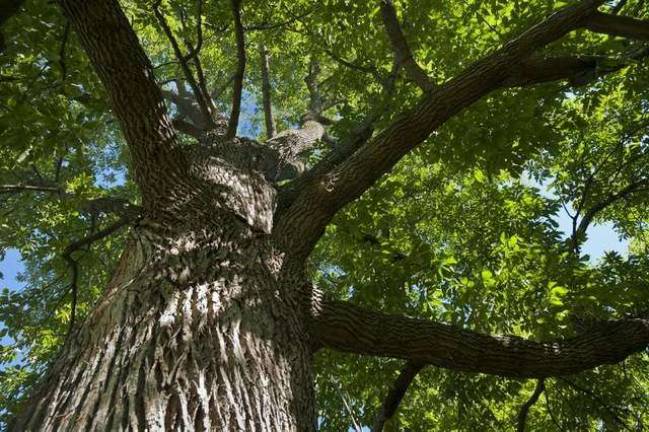Ash trees disappear across Pennsylvania


By JIM HOOK
SCOTLAND, Pa. (AP) — The eradication of ash trees from Pennsylvania's landscape and forests got a public viewing recently.
Crews felled large-diameter trees dating to the early days of the Scotland School for Veterans Children.
“We hate to see the trees go, and the tree-shaded entrance, but it had to happen because of the beetle infestation," said Dr. David Newell, president and CEO of the Scotland Campus. “Two trees just fell over on the entrance road. They blocked traffic for a day."
The campus, currently home to Winebrenner Theological Seminary, showcases the might of the half-inch emerald ash borer. About 70 ash trees across campus must come down, according to Newell. Branches have fallen from some trees.
“The emerald ash borer is the most destructive exotic forest pest in North America since chestnut blight and Dutch elm disease, with the ability to potentially destroy the entire ash genus," according to a forestry management plan for the Pennsylvania Department of Conservation and Natural Resources.
White ash in 2011 was the seventh most abundant tree species in Pennsylvania. A small area of Pennsylvania and New York has supplied white ash for the Louisville Slugger, the official bat of Major League Baseball.
“The bottom line is that those forests that Louisville Slugger uses to harvest ash and make high-quality bats are being devastated by emerald ash borer over time," a company spokesman said recently.
The beetle, an Asian invader, threatens to kill nearly all ash trees within a few years of infestation, according to researchers.
Individual ash trees can be saved, but each tree must receive an injection every two years.
“They've done well if we were able to treat them earlier, before they were infested heavily," said Brad Evans, Chambersburg manager of Bartlett Tree Experts. “We've treated thousands of trees."
Bartlett began treating ash trees in Franklin County about three years ago. Treating tree now would not be as effective as earlier treatment.
“The healthier the tree, the better the treatment works," said Jamey Schwartz of Cumberland Valley Tree Service. “We have tried to treat as many trees as our clients can treat. If at least 50 percent of the tree is alive, there's a chance it will survive. We're at the point where we're cutting down about half the trees we find. It's unfortunate."
He's treated ash trees whose trunks are 50 inches in diameter.
The historically hardy ash is native to Pennsylvania and can grow to 80 feet and live more than 100 years. It doesn't have the aesthetic value of maple tree or hemlocks, but its timber is valued. The potential damage to the U.S. economy by 2019 may exceed $10 billion across the 25 affected states, according to DCNR.
DCNR has a 10-year, $1.8 million plan to cull hazardous trees from state land and to save a few trees in hopes of bringing back the ash tree.
Michaux State Forest had a small sale to salvage timber from dying ash along U.S. 30, according to Michaux forester Roy Brubaker.
“The market for ash is pretty strong as long as there is enough volume to interest a buyer and the trees aren't too deteriorated," he said. “Lower quality and smaller trees won't have much value."
A major impactWhile users of the state may not see much change in the forest, the loss of the ash trees will be a major ecological impact in the surrounding landscape, particularly along streams and in the residential areas, he said.
The Penn State Mont Alto Arboretum is treating some of its specimen, or valuable, ash trees and removing others too badly infested, according to Beth Brantley, instructor of forest technology at Penn State Mont Alto. Established in 1903, the forestry school's collection contains more than 1,000 trees representing 174 species.
The outlook is grim, but not hopeless.
The emerald ash borer has devastated a research plot of 2,100 ash trees at the edge of Penn State's University Park. Kim Steiner, currently director of The Arboretum at Penn State, in 1978 planted seeds from green ash trees to understand how species adapt to their environments. The ash plantation is the largest collection of green ash germplasm at one location in the world and could play a significant role in saving the species.
“We have about 15 trees remaining that show little or no die-back from emerald ash borer," Steiner said. “They look pretty healthy, and we know that most of them have been attacked because they have exit holes where the adults have emerged after feeding on the inner bark."
Any level of genetic-based resistance could be something to build on to save the species, she said.
Penn State molecular geneticist John Carlson is looking at the genetic mechanisms by which surviving trees might be battling the insects. He has seen some biochemical or genetic responses. He and Steiner have been talking with DCNR officials about planting Penn State's lingering ash trees on state forest lands and in private forests.
Some trees inoculated with eggs from the ash borer actually seem to kill beetle larvae, according to research by Jennifer Koch at the U.S. Forest Service Laboratory in Delaware, Ohio.
DCNR plans to treat about 200 trees across Pennsylvania's 20 state forest districts, try biological controls at 10 sites and protect three seed orchards.
“The thought is that in another five to six years the large population of emerald ash borer will have moved out of the area simply because there's no food source," Evans said. “The population of insects is going to collapse. In four years we may be able to scale back on the time of treatment because there won't be the insect pressure there is now."
Meanwhile, major-league baseball players increasingly have turned to bats made of maple wood since 2001, when San Francisco Giants left fielder Barry Bonds used one in breaking the season home run record.
The beetle's reach U.S. timberland has an estimated 8 billion ash trees, 300 million of them in Pennsylvania forests.
Up to 100 million ash trees may have been killed by the emerald ash borer.
The emerald ash borer is a metallic green, wood-boring invasive insect that feeds exclusively on ash trees. Its larvae feed under the tree bark. They girdle and kill trees within four years of infestation.
The Asian beetles moved rapidly in North America after being first identified in 2002 in Michigan. Emerald ash borers showed up in Pennsylvania in 2007. Pennsylvania initially banned the in-state movement of firewood in an attempt to slow their advance, but gave up the quarantine in 2011. An interstate quarantine remains in effect.
The beetle's first appearances in the region came in 2010 in Cumberland and Fulton counties, 2012 in Franklin County and 2014 in Adams, Lebanon and York counties.
The pest currently infests forests from Colorado to Vermont and Georgia.
Woodpeckers are a sign of an insect infestation.
The emerald ash borer eats a D-shaped hole as it emerges from under the bark.
Online: http://bit.ly/2jyZSsV
Information from: Public Opinion, http://www.publicopiniononline.com